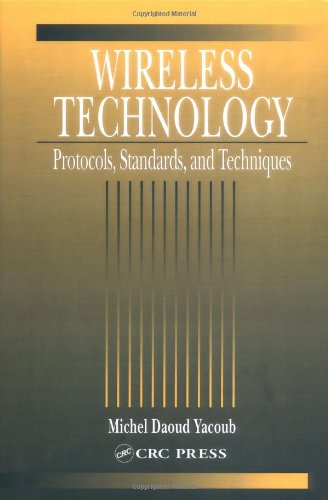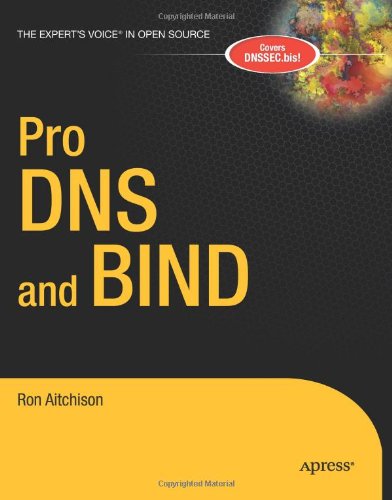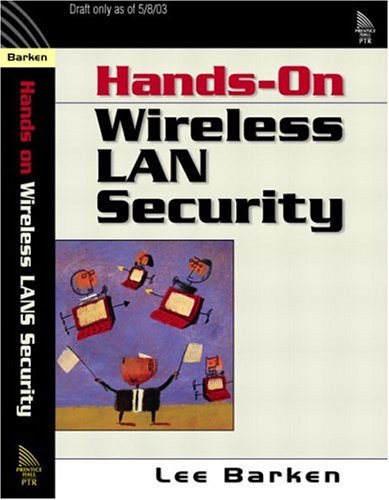Michel Daoud Yacoub9780849309694, 0849309697
Table of contents :
WIRELESS TECHNOLOGY Protocols, Standards, and Techniques……Page 3
Dedication……Page 5
Preface……Page 6
Acknowledgments……Page 9
Table of Contents……Page 10
Part I: Introduction……Page 22
1.1 Introduction……Page 23
1.2 Intelligent Network……Page 24
1.2.2 IN Elements……Page 25
1.2.3 Wireless Service Requirements……Page 27
1.2.4 Wireless IN Services……Page 28
1.2.5 IN Standards……Page 29
1.3 Network Architecture……Page 30
1.4 Protocol Architecture……Page 32
1.5.3 Logical Channel……Page 33
1.6 Narrowband and Wideband Systems……Page 35
1.7 Multiple Access……Page 36
1.7.3 Code Division Multiple Access……Page 37
1.8 Summary……Page 39
References……Page 40
2.1 Introduction……Page 41
2.2 Cellular Hierarchy……Page 42
2.3.2 Cell Selection……Page 43
2.3.4 Handover……Page 44
2.3.5 Mobility Support……Page 45
2.4.1 Interference Control……Page 46
2.5 Cellular Reuse Pattern……Page 47
2.6 Macrocellular Reuse Pattern……Page 49
2.6.1 Reuse Factor (Number of Cells per Cluster)……Page 50
2.6.2 Reuse Ratio……Page 51
2.6.3 Positioning of the Co-Cells……Page 52
2.7 Microcellular Reuse Pattern……Page 53
2.7.2 Reuse Ratio……Page 54
2.9 Interference in Narrowband Macrocellular Systems……Page 56
2.9.1 Downlink Interference-Omnidirectional Antenna……Page 57
2.9.3 Downlink Interference-Directional Antenna……Page 58
2.9.5 Examples……Page 59
2.10 Interference in Narrowband Microcellular Systems……Page 60
2.10.1 Propagation……Page 64
2.10.3 Downlink Interference……Page 65
2.10.4 Examples……Page 67
2.11 Interference in Wideband Systems……Page 70
2.11.1 Uplink Interference……Page 71
2.11.2 Downlink Interference……Page 73
2.12 Network Capacity……Page 74
2.12.2 Wideband Systems……Page 75
2.12.3 Uplink Load Factor……Page 76
2.12.4 Downlink Load Factor……Page 79
2.13 Summary……Page 80
References……Page 81
3.1 Introduction……Page 83
3.2.1 Frequency Domain……Page 85
3.2.3 Code Domain……Page 86
3.3 Duplexing……Page 87
3.3.2 Time Division Duplexing……Page 88
3.4 Multiple-Access Categories……Page 89
3.5 Scheduled Multiple Access……Page 91
3.5.1 Frequency Division Multiple Access……Page 92
3.5.2 Time Division Multiple Access……Page 93
3.5.3 Code Division Multiple Access……Page 95
3.5.4 Space Division Multiple Access……Page 99
3.5.5 Brief Remarks on Scheduled Multiple-Access Techniques……Page 105
3.6 Random Multiple Access……Page 106
3.6.1 ALOHA……Page 108
3.6.2 Splitting Algorithms……Page 111
3.6.3 Carrier Sense Multiple Access……Page 112
3.6.4 Brief Remarks on Random Multiple-Access Techniques……Page 115
3.7.1 Polling Controlled……Page 120
3.7.2 Token Controlled……Page 121
3.8 Hybrid Multiple Access……Page 122
3.8.1 Reservation-ALOHA (R-ALOHA)……Page 123
3.8.2 Packet Reservation Multiple Access (PRMA)……Page 124
3.8.3 Distributed Queuing Request Update Multiple Access ( DQRUMA)……Page 128
3.8.5 Dynamic TDMA with Piggyback Reservation (DTDMA/PR)……Page 129
3.8.6 Mobile Access Scheme Based on Contention and Reservation for ATM ( MASCARA)……Page 130
3.8.7 Dynamic TDMA with Time Division Duplex (DTDMA/TDD)……Page 131
3.8.8 Resource Auction Multiple Access (RAMA)……Page 132
3.9 Summary……Page 135
References……Page 137
Part II: 2G Systems……Page 139
4.1 Introduction……Page 140
4.2 Features and Services……Page 142
4.2.3 Supplementary Services……Page 143
4.3 Architecture……Page 144
4.3.1 Mobile Station Subsystem……Page 145
4.3.2 Base Station Subsystem……Page 147
4.3.3 Network and Switching Subsystem……Page 148
4.3.5 Open Interfaces……Page 150
4.4.1 Signal Processing……Page 151
4.4.3 Physical Channels……Page 153
4.4.4 Burst Formats……Page 155
4.4.6 Multiframes……Page 157
4.5.2 Frequency Correction Channel……Page 160
4.5.3 Synchronization Channel……Page 161
4.5.5 Paging Channel……Page 162
4.5.7 Random Access Channel……Page 163
4.5.8 Stand-Alone Dedicated Control Channel……Page 164
4.5.9 Slow Associated Control Channel……Page 165
4.6 Messages……Page 166
4.6.1 DLC Messages……Page 167
4.6.2 RRM Messages……Page 168
4.6.3 CM Messages……Page 170
4.6.4 MM Messages……Page 172
4.7.1 Mobile Initialization……Page 173
4.7.2 Location Update……Page 174
4.7.4 Ciphering……Page 175
4.7.6 Mobile Station Origination……Page 176
4.7.7 Handover……Page 177
4.8 Frequency Hopping……Page 178
4.9 Discontinuous Transmission……Page 179
4.11 Spectral Efficiency……Page 180
References……Page 181
5.1 Introduction……Page 183
5.2.1 Voice Features……Page 185
5.2.2 Short Message Service Features……Page 187
5.3.1 Mobile Station……Page 188
5.3.2 Base Station……Page 189
5.3.3 Mobile Switching Center……Page 190
5.3.8 Message Center……Page 191
5.3.14 Interface Reference Points……Page 192
5.4 Multiple-Access Structure……Page 193
5.4.1 Forward Link……Page 194
5.4.2 Reverse Link……Page 197
5.4.4 Logical Channels……Page 200
5.5.2 Sync Channel……Page 202
5.5.3 Paging Channel……Page 203
5.5.4 Access Channel……Page 204
5.5.5 Traffic Channel-Forward and Reverse Links……Page 205
5.6 Signaling Format……Page 209
5.7 Messages, Orders, and Parameters……Page 210
5.8 Messages and Orders and Logical Channels……Page 219
5.8.2 Sync Channel……Page 220
5.8.3 Paging Channel……Page 221
5.8.4 Access Channel……Page 224
5.8.6 Forward Traffic Channel……Page 225
5.8.7 Reverse Traffic Channel……Page 228
5.9 Mobile Station Call Processing……Page 230
5.9.1 Mobile Station Initialization State……Page 231
5.9.2 Mobile Station Idle State……Page 234
5.9.3 System Access State……Page 239
5.9.4 Mobile Station Control on the Traffic Channel State……Page 246
5.10.2 Paging Channel Processing……Page 252
5.10.3 Access Channel Processing……Page 254
5.10.4 Traffic Channel Processing……Page 255
5.12 Authentication……Page 263
5.12.1 Updating the Shared Secret Data……Page 264
5.12.2 Mobile Station Registrations……Page 265
5.12.4 Mobile Station Terminations……Page 266
5.12.5 Mobile Station Data Burst……Page 267
5.12.6 Unique Challenge-Response Procedure……Page 268
5.14 Voice Privacy……Page 269
5.16.1 Types of Handoff……Page 270
5.16.3 Handoff Parameters……Page 272
5.16.4 Handoff Messages……Page 274
5.16.5 Pilot Sets Updating……Page 275
5.17.1 Reverse-Link Power Control……Page 277
5.18 Call Procedures……Page 280
5.18.1 Mobile Station Origination……Page 281
5.18.2 Mobile Station Termination……Page 282
5.19 EIA/TIA/IS-95B……Page 283
5.19.1 Increase in the Transmission Rate……Page 284
5.19.3 Soft Handoff Criteria……Page 285
5.19.4 Hard Handoff……Page 286
5.19.6 Conclusions……Page 287
References……Page 288
Part III: Wireless Data……Page 289
6.2 General Packet Radio Service……Page 290
6.2.1 Network Architecture……Page 291
6.2.2 Protocol Architecture……Page 293
6.2.3 Data Flow and Data Structure……Page 294
6.2.4 Physical Channels and Logical Channels……Page 298
6.2.5 Medium Access……Page 299
6.2.6 Data Transfer Procedure……Page 302
6.2.7 Mobile-Originated Data Transfer……Page 303
6.2.9 Throughput Performance……Page 304
6.3 EIA/TIA/IS-95B……Page 307
6.4 High Data Rate……Page 308
6.4.1 HDR Solution……Page 309
6.4.2 Network Architecture……Page 310
6.4.3 Protocol Architecture……Page 312
6.4.4 Channels and Channel Structure……Page 315
6.4.5 Medium Access……Page 318
6.4.6 Throughput Performance……Page 320
6.4.7 Handoff Features……Page 322
6.4.8 HDR Summary……Page 323
References……Page 324
Part IV: 3G Systems……Page 326
7.1 Introduction……Page 327
7.2 Some Definitions……Page 328
7.3 Frequency Allocation……Page 330
7.4 Features and Services……Page 331
7.5 Traffic Classes……Page 335
7.6 IMT-2000 System and IMT-2000 Family……Page 336
7.6.1 Interfaces……Page 337
7.6.2 Global Roaming……Page 339
7.7 Specific Functions……Page 341
7.7.2 Radio Resource Management and Control Functions……Page 342
7.7.4 Radio Resource Request Acceptability Functions……Page 343
7.7.6 Handover Function……Page 344
7.7.7 Location Management and Geographic Position – Finding Functions……Page 345
7.7.8 Mobile Call Handling Functions……Page 346
7.7.10 Network Intelligence and Service Control Functions……Page 347
7.7.12 Emergency Services Functions……Page 348
7.7.14 Support of Users Function……Page 349
7.7.16 Messaging Service Management Functions……Page 350
7.7.17 Software-Configurable Terminals Functions……Page 351
7.8.1 Physical Entities-Reference Model……Page 352
7.9 Physical Entities and Functional Entities……Page 354
7.9.2 Mobile Terminal……Page 355
7.9.3 Base Station……Page 357
7.9.4 Radio Network Controller……Page 358
7.9.8 Gateway MSC……Page 359
7.9.11 Mobile Switching Center……Page 360
7.9.12 Packet Data Gateway Node……Page 361
7.9.15 Service Data Point……Page 362
7.10 Functional Entities and Their Interrelations……Page 363
7.11.1 Radio Transmission Technology……Page 365
7.11.3 Radio Transmission Technologies and Core Networks……Page 368
7.12.1 An Overview……Page 369
7.12.2 Network Architecture……Page 371
7.13 Summary……Page 372
References……Page 374
8.1 Introduction……Page 375
8.2 Network Architecture……Page 376
8.3 Protocol Architecture……Page 382
8.3.2 Transport Network Layer……Page 384
8.4 Radio Interface Protocol Architecture……Page 385
8.4.1 Layer 3……Page 388
8.4.2 Layer 2……Page 389
8.4.3 Layer 1……Page 392
8.5 Logical Channels……Page 393
8.6 Transport Channels and Indicators……Page 394
8.7.1 UTRA FDD Physical Channels……Page 396
8.7.2 UTRA TDD Physical Channels……Page 397
8.8 Mapping of Channels……Page 398
8.9 Physical Layer Transmission Chain……Page 399
8.10.1 UTRA FDD Uplink Physical Channels……Page 404
8.10.2 UTRA FDD Downlink Physical Channels……Page 408
8.10.3 UTRA TDD-3.84……Page 414
8.10.4 UTRA TDD-1.28……Page 417
8.11.1 Uplink Spreading……Page 420
8.11.2 Downlink Spreading……Page 423
8.12.1 Channelization Codes……Page 424
8.12.2 Uplink Scrambling Codes……Page 426
8.12.3 Downlink Scrambling Codes……Page 429
8.13.1 Cell Search……Page 431
8.13.3 Radio Link Establishment and Monitoring……Page 432
8.13.4 Uplink DPCCH and DPDCH Reception……Page 434
8.13.6 Downlink Power Control……Page 435
8.13.8 Random-Access Procedure……Page 437
8.13.9 CPCH Access Procedure……Page 439
8.13.10 Transmit Diversity……Page 441
8.13.11 Handover Procedure……Page 444
8.13.13 Dynamic Channel Allocation……Page 445
8.14 Interference Issues……Page 446
8.15 Summary……Page 447
References……Page 448
9.1 Introduction……Page 449
9.2 Network Architecture……Page 451
9.2.1 Network Entities……Page 453
9.2.2 Reference Points……Page 457
9.3 Radio Interface Protocol Architecture……Page 459
9.3.2 Layer 2……Page 460
9.4 Logical Channels……Page 463
9.5 Physical Channels……Page 465
9.6 Mapping of Channels……Page 467
9.7 Achievable Rates……Page 469
9.8.1 General……Page 470
9.8.3 Physical Channels……Page 472
9.8.4 Radio Configuration……Page 473
9.8.5 Power Control……Page 474
9.8.6 Transmit Diversity……Page 476
9.8.7 Transmission Block……Page 478
9.9.1 General……Page 481
9.9.3 Physical Channels……Page 482
9.9.4 Radio Configuration……Page 484
9.9.5 Transmission Block……Page 485
9.10 Forward Physical Channels……Page 487
9.10.2 Forward Transmit Diversity Pilot Channel……Page 488
9.10.5 Forward Dedicated Auxiliary Pilot Channel……Page 489
9.10.7 Forward Paging Channel……Page 490
9.10.8 Forward Broadcast Control Channel……Page 491
9.10.10 Forward Common Control Channel……Page 493
9.10.11 Forward Common Assignment Channel……Page 496
9.10.12 Forward Common Power Control Channel……Page 497
9.10.13 Forward Fundamental Channel and Forward Supplemental Code Channel……Page 498
9.10.14 Forward Fundamental Channel and Forward Supplemental Channel……Page 499
9.10.15 Forward Dedicated Control Channel……Page 501
9.11 Reverse Physical Channels……Page 504
9.11.2 Reverse Enhanced Access Channel……Page 506
9.11.3 Reverse Common Control Channel……Page 507
9.11.4 Reverse Pilot Channel and Reverse Power Control Subchannel……Page 508
9.11.5 Reverse Fundamental Channel and Reverse Supplemental Code Channel……Page 509
9.11.6 Reverse Fundamental Channel and Reverse Supplemental Channel……Page 510
9.11.7 Reverse Dedicated Control Channel……Page 511
9.12 High-Rate Packet Data Access……Page 512
9.12.1 Forward Link-General……Page 513
9.12.2 Forward-Link Channels……Page 516
9.12.6 Reverse Link-General……Page 518
9.12.7 Reverse-Link Channels……Page 522
9.12.8 Reverse-Link Quadrature Spreading……Page 524
9.12.11 Open-Loop Power Control Operation……Page 525
9.13 Summary……Page 528
References……Page 529
Part V: Appendices……Page 530
Appendix A: Open Systems Interconnection……Page 531
Appendix B: Signaling System Number 7……Page 534
Appendix C: Spread Spectrum……Page 536
C.1 Correlation……Page 537
C.2 Pseudonoise Sequences……Page 539
C.4 Orthogonal Variable Spreading Factor Codes……Page 540
C.5 Rake Receiver……Page 541
C.6 Processing Gain……Page 542
C.7 Direct Sequence Spread Spectrum……Page 543
C.8 Frequency Hopping Spread Spectrum……Page 544
Appendix D: Positioning of the Interferers in a Microcellular Grid……Page 545
D.3 Odd Nonprime Noncollinear Type……Page 546
D.4 Prime Noncollinear Type……Page 547







Reviews
There are no reviews yet.